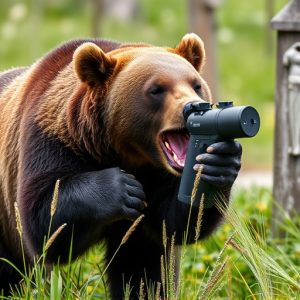Bear Spray Safety: Unlocking Alaska’s Wilderness Defense
Bear spray, a vital tool for Alaskans and outdoor enthusiasts, is designed to deter and repel bears…….
Bear spray, a vital tool for Alaskans and outdoor enthusiasts, is designed to deter and repel bears using capsaicin. Unlike pepper spray, it targets breathing and vision rather than just the eyes, offering a safer escape route from aggressive bears. With higher capsaicin concentrations than regular pepper spray, bear spray can be up to 10 times stronger. Proper storage and handling are crucial for maintaining its effectiveness. Comparing their strengths is less relevant; understanding each's unique capabilities in bear encounters is key for choosing the right self-defense option.
In Alaska’s rugged wilderness, encountering bears is a real possibility. Understanding bear spray—a vital safety tool—is crucial for outdoor enthusiasts and residents alike. This article delves into the effectiveness of bear spray compared to pepper spray, exploring its active ingredients, safe usage, and storage practices. Discover why bear spray is often considered stronger than pepper spray in terms of stopping aggressive bear encounters, ensuring your time in Alaska’s great outdoors is both enjoyable and secure.
- Understanding Bear Spray: A Vital Safety Tool for Alaska's Wilderness
- The Science Behind Bear Spray: Active Ingredients and Their Effectiveness
- Pepper vs Bear Spray: Comparing Strengths and Applications
- Safe Usage and Storage of Bear Spray: Ensuring It's Stronger Than Perception
Understanding Bear Spray: A Vital Safety Tool for Alaska's Wilderness
Bear spray, a vital safety tool for anyone venturing into Alaska’s wilderness, is designed to deter and repel bears when used correctly. Unlike pepper spray, which primarily targets the eyes and respiratory system, bear spray is specifically formulated to create a barrier between you and the bear, using capsaicin as its active ingredient. This potent chemical irritates the bear’s sensitive nasal membrane, causing it to associate the scent with negative experiences and retreat.
While many people wonder if bear spray is stronger than pepper spray, it’s important to understand that their effectiveness lies in different mechanisms. Pepper spray temporarily blinds and disorients, while bear spray disrupts the bear’s ability to breathe and see, creating a safe escape route. The strength of bear spray isn’t measured in comparison to pepper spray but in its ability to protect users from potentially deadly encounters with bears.
The Science Behind Bear Spray: Active Ingredients and Their Effectiveness
Bear spray, also known as bear repellent, has become an indispensable tool for outdoor enthusiasts navigating Alaska’s rugged terrain. The science behind its effectiveness lies in its active ingredients and how they interact with a bear’s sensory system. Typically, these sprays contain capsaicin, the same compound that makes chili peppers spicy. However, unlike pepper spray designed for human self-defense, bear spray is formulated to be much stronger, often containing higher concentrations of capsaicin. This heightened concentration ensures it can deter even the most aggressive bears.
The active ingredients in bear spray create a burning sensation and irritation in a bear’s eyes, nose, and respiratory system when sprayed directly at close range. This triggers a natural instinct to avoid and flee, making bear spray a powerful tool for self-defense in bear country. Interestingly, while pepper spray might leave users feeling vulnerable due to its targeted nature, bear spray is designed to be non-lethal and merely incapacitate the bear temporarily, allowing humans to retreat safely. Thus, when considering Is Bear Spray Stronger Than Pepper, it’s evident that specialized bear repellents surpass conventional pepper spray in terms of potency and purpose.
Pepper vs Bear Spray: Comparing Strengths and Applications
When it comes to self-defense against bears, pepper spray and bear spray are two commonly used options. However, understanding their strengths and applications is crucial in making an informed choice. Many people wonder, “Is bear spray stronger than pepper spray?”
Bear spray, as the name suggests, is specifically designed for use against bears. It typically contains capsaicin, the active ingredient found in chili peppers, but in much higher concentrations. This concentrated formula allows bear spray to be effective at a longer range and can even penetrate thick fur, making it a powerful tool for deterring aggressive bears. On the other hand, pepper spray is more versatile and often used for general self-defense against various threats, including humans. While still potent, pepper spray usually has lower concentrations of capsaicin and may not be as effective against large predators like bears at close range.
Safe Usage and Storage of Bear Spray: Ensuring It's Stronger Than Perception
Bear spray, a powerful deterrent, is often perceived as less potent than traditional pepper spray. However, this notion is far from accurate. Bear spray contains capsaicin, similar to pepper spray, but in much higher concentrations tailored for wildlife encounters. Its strength can be up to 10 times that of standard pepper spray, making it an effective tool against aggressive bears.
Proper usage and storage are key to ensuring its effectiveness. Always follow the instructions provided by the manufacturer. Keep bear spray readily accessible, yet secured out of reach from children and pets. Store it in a cool, dry place, away from direct sunlight, which can degrade its potency. Regularly inspect the spray for any signs of damage or expiration, replacing it as needed to maintain optimal performance.
In light of these discussions, it’s clear that bear spray is a powerful and necessary tool for navigating Alaska’s wilderness. When used correctly, it can be significantly stronger than pepper spray, offering a critical line of defense against bears. Always remember the importance of understanding, practicing, and storing bear spray safely to ensure your protection in unpredictable environments.


